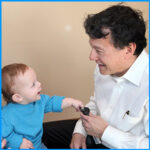EarWell™ and Other Treatments
In this section we look at two very effective treatments:
- Excision of a preauricular cyst
- EarWell™
The specialists at ENT for Children diagnose and treat a broad range of ear related conditions in children. Excision of a preauricular cyst and EarWell™ are two very effective treatments we are highly experienced with.
Excision Preauricular Pit or Cyst
A preauricular pit is known as a preauricular sinus or cyst. A preauricular pit is a small skin lined opening that most often is found in front of the ear. They lead from the surface of the skin to deep within the tissue and sometimes even into cartilage branching out like the limbs of a tree. The condition is present from birth and occurs due to abnormal development of the ear while the baby is in the womb.
Preauricular pits are a very common congenital abnormality. Many people live their entire life without ever needing treatment or removal of the pit. Surgery to remove the preauricular pit should be considered for children who exhibit the following symptoms:
- Swelling or redness around the pit.
- White or Yellow discharge from the pit.
- History of prior infection in the pit
- History of prior abscess formation secondary to the pit that may have led to incision and drainage.
- Pain or sensitivity around the pit.
Surgery to remove the pit involves removal of the pit, the entire tract, a small amount of surrounding skin, and the underlying tissue to prevent recurrence of the pit.
EarWell™
The EarWell™ Infant Ear correction system is a new treatment option to re-shape misshapen ears in newborn infants. The treatment is carried out by your ENT for Children physician and utilizes a series of splints that are applied with adhesive to your child’s ear. The process does not require sedation, anesthesia or surgery. The procedure is done entirely in our office and is painless.
The EarWell™ system is designed to improve or correct the appearance of a variety of common abnormalities that compromise the shape of your baby’s ear. The system is most effective when it is fit to your baby’s ear during the first 3 weeks of life. The length of treatment ranges from 4-8 weeks. Our office will determine if this new procedure is covered by your insurance.


